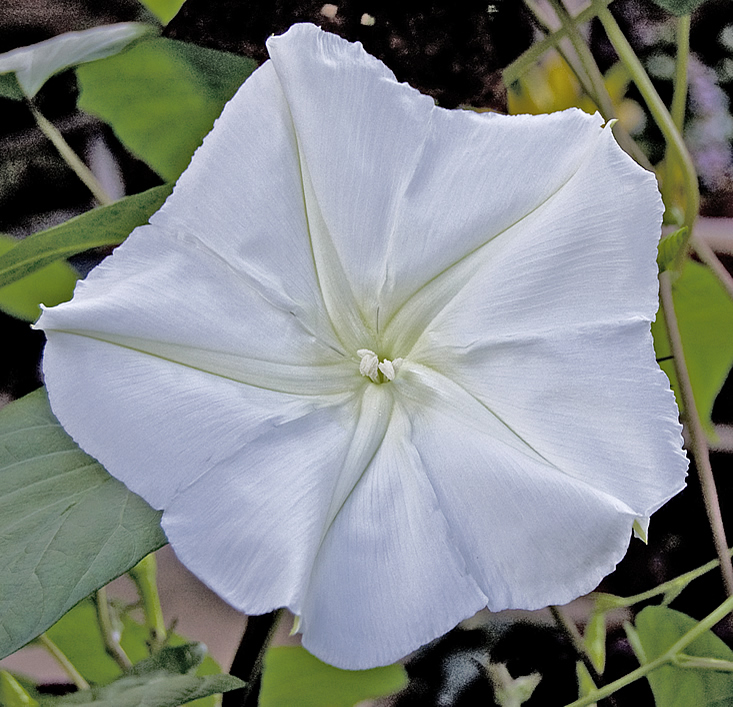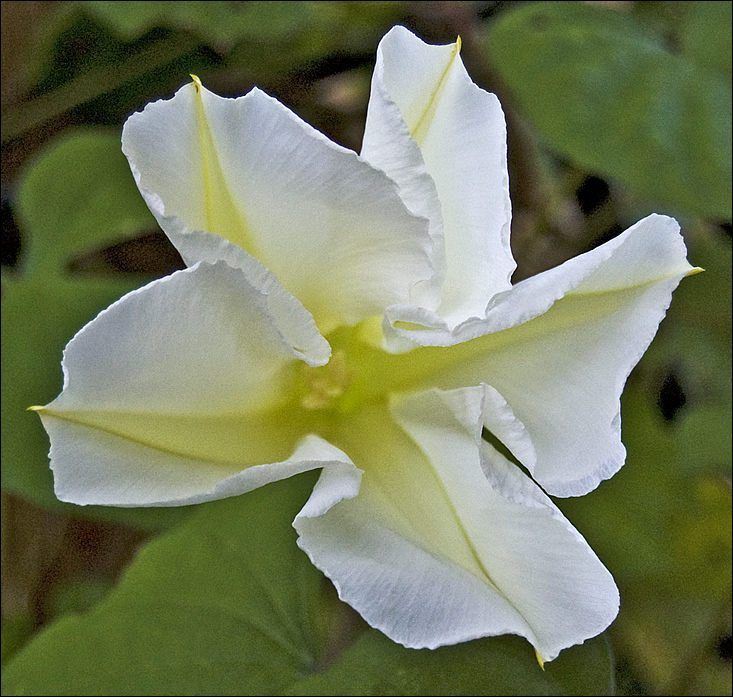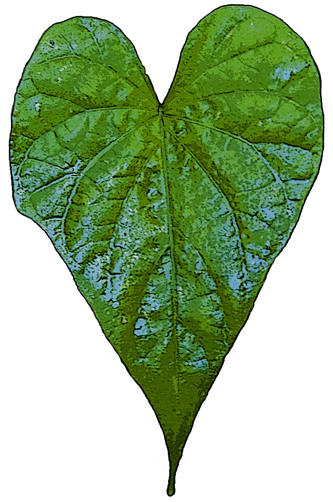|
|
|
|

  Ipomoea albaOn the veranda at Crow's Cottage • September 15, 2010
By Ebenezer Baldwin Bowles Posted on October 26, 2010, from Fayetteville, ArkansasTonight. Join me in the nocturnal garden. Fall into the radiating vortex of a starry moonflower and see where the rays of the aster carry us. But we must be quick! The bloom shall be gone for good by the morning. The moonflower — it is our mystery of the midnight hour — evokes a memory of the mayfly on the green river — the night the flight of ephemera came on diaphanous wings, a throng of millions attracted to a hot searchlight affixed to the pilothouse of a powerful towboat — reminds me of life's quickening brevity, and my place on the one line leading into infinity. I stand a mere tick to the right of the axis, close to the spoke. The axis creates a quadrant for time and prescience, dividing the upward passage to heaven from the downward tunnel to hell, and making spatial sectors with qualities both known and not known. For now, all I can see is my place in the moment, over there on the right side of the vertical, facing east. I move away from the negative numbers. They are emblazoned by a finger of fire on a padlocked gate at the outskirts of Eden. I turn my back.
“May I, the ephemeral, ne'er scrutinize How short is short when it comes to a life? My sister-in-law from an island on Great River sent the moonflower seeds as a gift for the garden, and then during the early spring the mistress of the hacienda planted them in tiny pots, and then they sprouted, little leaves shaped like hearts, and we tended the young plants until the earth grew warm from summer's sun, and then we planted the seedlings in various places in the garden: one in the clay angel's arms next to the north fence, another in a pot beside the outdoor swing, a third in a little bowl next to the lattice-lined wall of the plant hospital, a fourth in a rectangular planter at the edge of the veranda. Now, early in the autumn, each is a swirl of viny vegetation, making moonflowers to open in the night. I can't escape questions when a mystery appears — and a garden properly contemplated is fertile ground for mysteries. Questions aren't as complicated as answers. As kernels of the antithesis, questions provide openings for ramblings, guesswork, interpretations. Who needs answers when there's no crime to solve, no one's future to decide, no irreversible direction to choose for the morrow? 
Moonflower calyx ~ September 16, 2010
When the light fades in the gloaming and dark begins to gather, the tightly wrapped calyx unfurls, slowly, to reveal its majestic surprise, a luminous swirl of pearly white in the shadowy night. Our friend Deborah of the lowlands tells us that during her hippie phase some four decades ago, she attended a moonflower watch party where herbs and elixirs heightened the experience of observing the night blooming beauties as they opened under the pale of a full moon. The bloom needs about an hour to unveil its full grandeur, she reports — plenty of time for dreamy and collective contemplation of Nature's wonders. Unopened, the spirally-coiled cone calls up the shape of the shell of a chambered nautilus, or vanilla swirl ice cream tall in a cone. The surface texture of the opened flower resembles tightly woven Egyptian cotton, slightly wrinkled, or burnished silk stretched loosely between spokes of a pentagonal frame. But to the touch, the flower is delicate and easy to tear. 
The other side of a moonflower ~ October 2, 2010
How do I begin to understand ephemera, the swiftly passing thing with its single night of animated existence? Can the vital brevity of the flower and the fly be so comparatively different from the decades-long life of the actuarial man when each is stacked against the length of eternity? We hear the goddess Urania speak, grieving for the loss of the love of her life, sweet Adonais:
"The sun comes forth, and many reptiles spawn; I've experienced a swarm of mayflies, drawn on translucent wing to the powerful electric lamps of the thousand-horsepower riverboat Martha Anne. I remember with unusual vividness the foggy night thirty-three springs ago when the
The great swirling body of insects encircled us in the pale gray mist — a thick and frenetic throng stretching as far as the eye could see, the mind could imagine. But they came not like the pestilence of the locust in the field, but rather like delicate swathes of evanescent beauty on a canvas, or like excited particles of primal drama, projected onto a silver screen, or like fragments of souls streaming toward the Limitless Light. In the morning they were dead, great droves of them ankle-deep on the decks, crunch crunch under the force of thick leather work boots, others in clusters and mounds on the dewy surfaces of coiled ropes and stacked ratchets, remnants of the swarm strewn like crystalline echoes on every steel surface and 'tween every nook and cranny of the motor vessel Martha Anne. It took hours for Dicus 'n me to sweep the fallen shells into the cold green water of the Cumberland River. We were hard at the task long after Captain Donohoe had fired up the engines and steered us into the channel. We were headed south toward Nashville.
In shoals the hours their constant numbers bring, 
A moonflower about halfway open ~ October 6, 2010 Moonflower
Kingdom: Plantae Mayfly and moonflower as symbols of a transitory existence reach all the way back to antiquity. A scribe tells us that the ephemeron as a singular noun originally denoted a plant said by the Ancients to last only one day. Among insects, the mayfly belongs to the order Ephemeroptera, a creature so ephemeral that it is born without a mouth, having no need to eat before it mates and dies. In the chambers of destiny sit the Daughters of Night, spinning and measuring the thread of my life. Clotho the spinner and Lachesis the measurer have done their tasks with the spindle and the rod. Now I await the inevitable, imperious final act from the hands of Atropos, she who cannot be turned, she who holds the shears that shall cut the thread. How much should I ponder the question, What portion of the length of life's linen ribbon remains for me at this late hour? My answer: Not much. Even there, snared in the imprecision of thought and expression, arises the unintended paradox, setting the act of contemplation against the mystery of how many moons might remain for a man, a life, a flower, or a fly. I have little time to devote to riddles. Time enough to search for the beauty in all things, great and small.   Leaf of the moonflower vine ~ 11 x 14 centimeters ~ September 16, 2010
A Moonlight GardenI plant a garden like none other; not an everyday garden, nor indeed a garden of any day, but a garden for "brave moonshine," a garden of twilight opening and midnight bloom, a garden of nocturnal blossoms, a garden of white blossoms, and the sweetest garden in the world. It is a garden of my dreams, but I know where it lies, and it now is smiling back at this very harvest moon. . . . . Here at the end of the garden walk is an arbor dark with the shadow of great leaves, such as Gerarde calls "leaves round and big like to a buckler." But out of that shadowed background of leaf on leaf shine hundreds of pure, pale stars of sweetness and light, — a true flower of the night in fragrance, beauty, and name, — the Moon-vine. It is a flower of sentiment, full of suggestion.
Alice Morse Earle L I N K S
P O S T S C R I P T"Fanny began saying how wonderful the sunset was last night, and asking did he ever see the moon-vine flowers pop out in the gloaming...." — from a story by Herbert Quick, "Old Hen and the Experts," in The Century Magazine, Vol. LXXVII, November 1908. Notices announcing new entries for Crow's Cottage Glossary and Compendium are sent by e-mail express to my list of family, friends, students, and fellow travelers. If you've come here by some other means, I invite you to write me at the address below so I can add you to the list. It's a private list, shared with no one and guarded to the max by a flock of warrior crows. Or protected by magic fairies with tricks of illusion. Aggressive or pacific — you choose — the guardians are in our service to ensure your privacy. Ebenezer Bowles |
|

|
|
|
 creatures came by the tens of thousands to dance and dip in the shimmering white-hot beam of the searchlight, the amber glow of the caged running lights. Captain Donohoe was loathe to navigate downstream in the thickening fog, so he nudged the vessel gently against the right bank to allow me and fellow deckhand Terry Dicus to lower a ladder, scramble onto the slippery bank, and find a mooring tree for the night.
creatures came by the tens of thousands to dance and dip in the shimmering white-hot beam of the searchlight, the amber glow of the caged running lights. Captain Donohoe was loathe to navigate downstream in the thickening fog, so he nudged the vessel gently against the right bank to allow me and fellow deckhand Terry Dicus to lower a ladder, scramble onto the slippery bank, and find a mooring tree for the night.